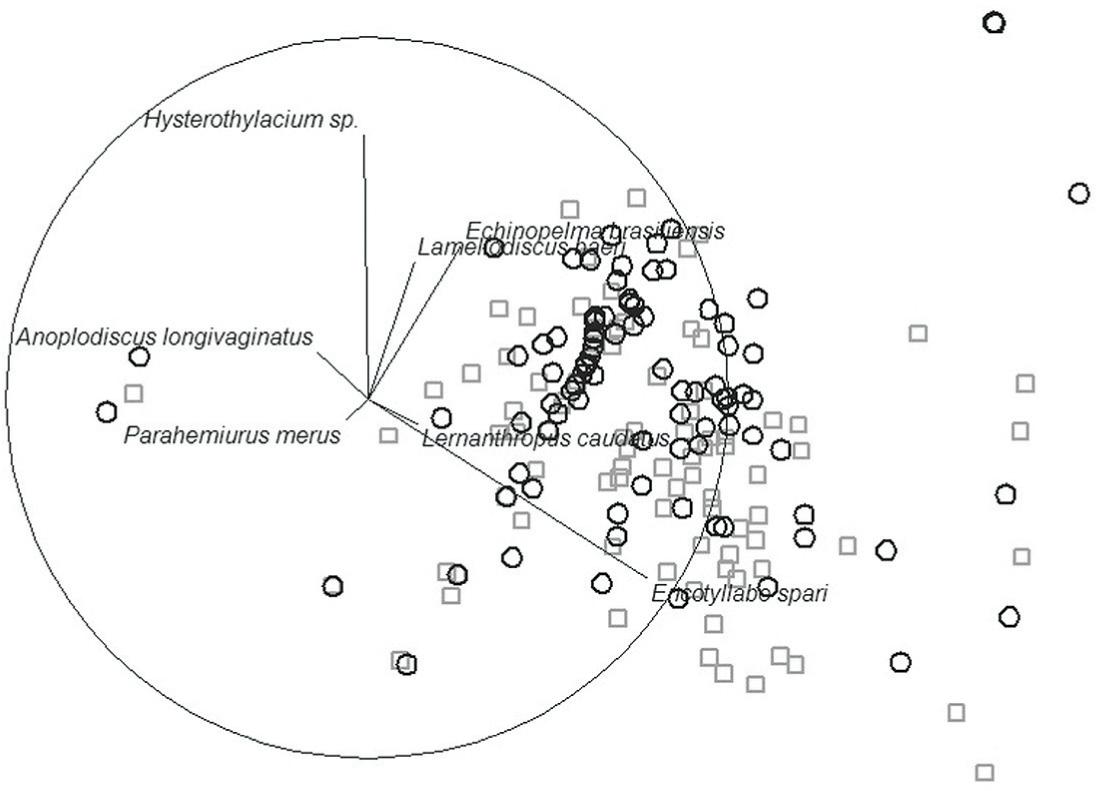Table 1.
Comparison of the prevalence, intensity, mean intensity, abundance and infection site of metazoan parasites of Pagrus pagrus in the coastal region of the state of Rio de Janeiro, Brazil, collected in the study by Paraguassú et al. (2002)Paraguassú AR, Luque JL, Alves DR. Community ecology of metazoan parasites of red porgy Pagrus pagrus (L., 1758) (Osteichthyes, Sparidae) from the coastal zone, State of Rio de Janeiro, Brazil. Acta Sci, Biol sci 2002; 24(2): 461-7.(P1) and in the present study (P2).
Table 2.
Spearman's rank correlation coefficient (rs) and Pearson's correlation coefficient (r) values used to evaluate possible relationships between the total length of Pagrus pagrus, and the abundance and prevalence of its parasite community components, in the coastal region of the state of Rio de Janeiro, Brazil, in the study by Paraguassú et al. (2002)Paraguassú AR, Luque JL, Alves DR. Community ecology of metazoan parasites of red porgy Pagrus pagrus (L., 1758) (Osteichthyes, Sparidae) from the coastal zone, State of Rio de Janeiro, Brazil. Acta Sci, Biol sci 2002; 24(2): 461-7.(P1) and in the present study (P2) (significance: P ≤ 0.05).
Table 3.
Characteristics of the parasite infracommunities of Pagrus pagrus in the coastal region of the state of Rio de Janeiro, Brazil. t = Student test value for comparison between the hosts, in the study by Paraguassú et al. (2002)Paraguassú AR, Luque JL, Alves DR. Community ecology of metazoan parasites of red porgy Pagrus pagrus (L., 1758) (Osteichthyes, Sparidae) from the coastal zone, State of Rio de Janeiro, Brazil. Acta Sci, Biol sci 2002; 24(2): 461-7.(P1) and in the present study (P2).
Table 4.
Spearman correlation coefficient values (rs) and chi-square values (χ2) for co-occurrences of ectoparasite species pairs in Pagrus pagrus from the coastal region of the state of Rio de Janeiro, Brazil, in the study by Paraguassú et al. (2002)Paraguassú AR, Luque JL, Alves DR. Community ecology of metazoan parasites of red porgy Pagrus pagrus (L., 1758) (Osteichthyes, Sparidae) from the coastal zone, State of Rio de Janeiro, Brazil. Acta Sci, Biol sci 2002; 24(2): 461-7. (P1) and in the present study (P2).
Table 5.
Comparison of prevalence values (χ2) and abundance values (Mann-Whitney U test) for helminth community component species in Pagrus pagrus from the state of Rio de Janeiro, in the study by Paraguassú et al. (2002)Paraguassú AR, Luque JL, Alves DR. Community ecology of metazoan parasites of red porgy Pagrus pagrus (L., 1758) (Osteichthyes, Sparidae) from the coastal zone, State of Rio de Janeiro, Brazil. Acta Sci, Biol sci 2002; 24(2): 461-7.(P1) and in the present study (P2) (significance: P ≤ 0.05).
Table 6.
Effects explaining variation in the abundance of seven parasite species, revealed by permutational multivariate analyses of variance (PERMANOVA) based on Bray-Curtis similarities to the log(x+1) transformed abundance matrix. Only significant effects are listed. Permutational test for homogeneity of multivariate analysis (PERMDISP) was applied to test for differences in dispersion among groups formed by the factors that had significant effects in PERMANOVA.

